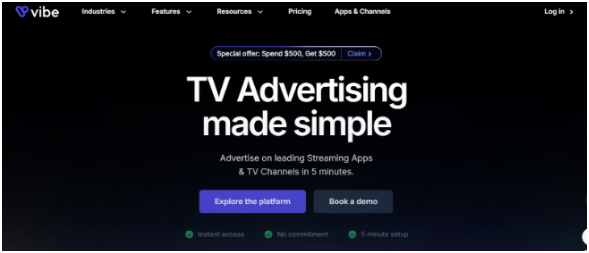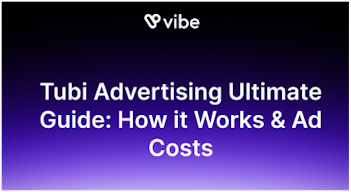Hulu Advertising: Is It Worth It?
If you’re exploring video advertising platforms, Hulu has likely caught your attention.
With millions streaming daily, Hulu’s ad-supported model offers a unique opportunity to engage highly active audiences.
Choosing the right platform for your campaign is crucial, and that’s where this blog comes in.
Here, I’ll break down the key question: Is Hulu Advertising worth it? Let’s find out!
Here’s what I’ll cover:
- How Hulu Advertising works: What makes it unique in the crowded streaming space?
- Costs and budgeting: Is it affordable for your business or better suited for larger brands?
- Pros and cons: What you’ll love about Hulu—and what might hold you back.
- Alternatives: How Hulu compares to competitors like YouTube and TikTok.
By the end of this blog, you’ll clearly understand whether Hulu Advertising aligns with your business goals or if another platform might be a better fit.
Let’s get started!
What Is Hulu and What Is Hulu Advertising?
Hulu is a streaming platform where people watch on-demand TV shows, movies, and live content.
It works on smart TVs, phones, tablets, and computers, making it accessible to a wide audience.
Hulu TV Advertising allows businesses to show ads to Hulu viewers while they watch their favorite shows.
These ads are integrated into the streaming experience, appearing before, during, or after the content.
With millions of users, Hulu Advertising helps brands engage with diverse audiences engagingly.
It’s not just about showing ads—it’s about making them part of the viewer's entertainment.
Types of Ads on Hulu Advertising
Hulu provides various ad formats to match different audience behaviors, helping your message connect effectively with viewers.
1. Video Ads:
- These are short ads that play before, during, or after a show
- A typical example is a 30-second product ad shown during breaks in a popular program.
- These ads engage viewers by appearing at moments when they are already attentive.
2. Branded Content:
- This format integrates products directly into Hulu’s shows.
- For example, a character in a series might use a product or service as part of the storyline.
- Branded content creates a natural connection between the viewer and the brand.
3. Pause Ads:
- Pause ads are displayed when viewers pause their show or movie.
- The ad appears on the screen during the pause without disrupting the viewing experience.
- This format uses idle moments to subtly showcase a product or service.
4. Binge Ads:
- Binge ads are designed for viewers watching multiple episodes in one sitting.
- After a few episodes, an ad may thank the viewer for their dedication and promote a brand or product.
- These ads resonate with viewers by aligning with their viewing habits.
Hulu Advertising works because millions of people use the platform.
These viewers come from different backgrounds, giving your ads a wide reach.
If you think about it, your ad becomes part of someone’s favorite content. That’s what makes Hulu Advertising unique—it’s about meeting viewers where they are.
So, How Does Hulu Advertising Work?
- Hulu Advertising places your ads within the shows viewers are already watching.
- It ensures your brand reaches engaged audiences.
- You can target based on age, location, or interests. For example, show ads for fitness products to health-conscious viewers.
- Hulu also tracks viewing habits. If someone loves cooking shows, your food ad can appear while they watch.
- Ads are shown on TVs, phones, and tablets. This allows you to reach people no matter how they stream.
- The ads play during breaks or pauses in shows. This way, your message fits naturally into the viewer’s experience.
By using Hulu’s smart targeting and flexible ad placements, you can connect with the right people at the right time.
Hulu Advertising Costs: What You Need to Know
When you advertise on Hulu, you pay based on how many people see your ad. This is measured using CPM, which stands for Cost Per Thousand Impressions.
For example, if the CPM is $20, you pay $20 for every 1,000 times your ad is shown.
Hulu offers a self-service advertising platform called Hulu Ad Manager, designed for small and medium-sized businesses.
While specific CPM rates are not publicly disclosed, Hulu's advertising solutions are designed to accommodate various budget sizes, making them accessible for businesses with different marketing budgets.
Several factors can influence the cost of your Hulu advertising campaign:
- Audience Size: If you aim to reach a large number of viewers, your costs may increase. For instance, targeting a nationwide audience will generally cost more than focusing on a specific city or region.
- Precision of Targeting: The more specific your target audience, the more it might cost. For example, showing your ad to left-handed guitar players in their 30s could be more expensive than targeting all music enthusiasts.
- Ad Creative Quality and Duration: High-quality, longer ads may cost more to produce and place. A 60-second high-definition ad will likely cost more than a 15-second standard-definition one.
Understanding these factors can help you plan your budget effectively.
By considering your target audience and the quality of your ad, you can estimate the costs and make informed decisions about your Hulu advertising strategy.
What are the Pros and Cons of Hulu Advertising?
When considering Hulu Advertising, it's helpful to look at real user experiences. Here's what customers have shared:
Pros of Hulu Advertising:
1. Diverse Content Options:
- Many people enjoyed Hulu’s variety of shows and movies.
- Users shared that it is the best streaming platform with the most variety.
- If you want your ads shown during popular TV series, Hulu could work for you.
2. Ad Placement Opportunities:
- Advertisers appreciated that their ads appeared alongside well-known shows.
- A user said, “My brand looked great when placed with Hulu Originals like Handmaid’s Tale.”
- If you’re looking to boost credibility, this might appeal to you.
3. Reach Across Devices:
- Hulu works on smart TVs, tablets, and more.
- Another user commented, “The platform’s accessibility on multiple devices helped our campaign reach a larger audience.”
- This could be ideal if you want flexibility in ad delivery.
Cons of Hulu Advertising:
Now, let’s have a look at some of the cons of Hulu Advertising:
1. Too Many Ads:
- Some users found Hulu’s ads too frequent.
- Users shared that Hulu ads feel really annoying and it is even worse than cable.
- If you’re targeting a younger audience, consider how repeated ads might affect engagement.
2. Platform Glitches:
- Technical issues frustrated many users.
- One user shared, “Every time an ad plays on my Fire Stick, Hulu crashes. It’s a nightmare.”
- This is something to keep in mind if your audience uses streaming devices.
3. Customer Support Concerns:
- Customer Support Concerns: Users were unhappy with Hulu’s support.
- A reviewer wrote, “I couldn’t resolve basic issues with my account, and no one could help.”
- This could impact advertisers needing timely support for campaigns.
4. Cost vs. Ad Experience:
- Cost vs. Ad Experience: Some advertisers felt Hulu’s high CPM wasn’t worth the results.
- One reviewer said, “With the ad frequency and glitches, I’m not getting value for the cost.”
- Make sure the benefits align with your budget before investing.
So, are there better alternatives? Absolutely. Like I mentioned earlier, you’re in the right place. This blog has everything you need—and more—to help you decide.
Hulu Advertising vs. Alternatives
Now that you know the pros and cons of Hulu Advertising, you might be wondering how it compares to other platforms. Are there better options for your brand?
Let’s explore alternatives like YouTube, Netflix, and CTV platforms to help you make the best choice for your advertising goals.
Here’s a quick comparison to give you an overview:
| Platform | Reach | Targeting Options | Cost | Engagement |
|---|---|---|---|---|
| Hulu | Large audience on smart TVs | Demographics, location, behavior | Higher CPM (~$20) | Strong engagement during premium shows |
| YouTube | Global reach across devices | Interests, keywords, remarketing | Variable CPM (starting ~$4) | Highly interactive with skippable ads |
| Netflix | Growing ad-supported audience | Limited (newly launched) | Emerging ad pricing | Minimal interruptions; premium association |
| CTV | Tailored reach via connected TVs | Granular household-level targeting | Flexible pricing options | Seamless ad integration into the viewer experience |
Why CTV Advertising Works The Best?
CTV (Connected TV) advertising offers unique advantages that traditional platforms like Hulu or Netflix often can't match.
Here’s why it’s considered a better option in many scenarios:
- Precise Household Targeting
- Unlike broad targeting on Hulu, CTV advertising can pinpoint specific households.
- For instance, if you’re selling fitness gear, your ad can focus on homes with active lifestyles.
- Flexible Budgeting
- CTV platforms often have more budget-friendly pricing options compared to Hulu’s higher CPMs.
- This is especially helpful for smaller businesses with limited ad spend.
- Better Viewer Engagement
- CTV ads integrate smoothly into the viewing experience, reducing interruptions.
- This makes viewers less likely to skip or ignore the ads, boosting engagement.
- Broader Device Compatibility
- CTV works across smart TVs, gaming consoles, and even streaming devices, ensuring maximum reach.
- This flexibility makes it a versatile choice for campaigns targeting diverse audiences.
If CTV advertising sounds appealing, you’ll love what Vibe offers.
Designed to make connected TV ads seamless and effective, Vibe helps you achieve better results with advanced targeting and optimized ad placements.
Vibe.co: One of the Best CTV Advertising Platforms

Vibe is a CTV advertising platform built to maximize your ad’s impact.
Here’s why it stands out:
- Granular Targeting
- Vibe lets you target specific households based on viewing habits, location, or interests.
- For example, you can show your ad to families who watch kid-friendly content during prime hours.
- Dynamic Ad Integration
- Ads placed via Vibe blend naturally into the content.
- This ensures your audience sees your message without feeling interrupted or annoyed.
- Flexible Pricing Models
- Vibe offers cost-effective pricing, making it accessible to businesses of all sizes.
- You pay based on performance metrics, ensuring better ROI compared to fixed CPMs on Hulu.
- Actionable Insights
- Vibe provides detailed performance reports, helping you understand what’s working and optimize your campaigns.
- You’ll know exactly how your ads perform, down to household-level metrics.
While Hulu and Netflix are strong platforms for premium advertising, CTV platforms like Vibe offer unmatched precision, engagement, and flexibility.
With Vibe, you can create tailored campaigns that connect with your audience effectively—right where they’re watching.
If you’re looking for better ad performance at a flexible cost, CTV advertising with Vibe is worth considering.
So, Is Hulu Advertising Worth It?
So, is Hulu Advertising worth trying? That depends on your goals and budget.
Here’s a quick breakdown:
- Great for Premium Content: Hulu connects your brand with top TV shows and a loyal audience, giving your ads a premium feel.
However, this comes with higher ad costs, so it’s best suited for businesses with bigger budgets. - Good for Specific Targeting: Hulu allows advertisers to target specific demographics, such as parents or young adults.
But frequent ads can sometimes annoy viewers, potentially affecting their perception of your brand. - Alternatives to Consider: Platforms like YouTube offer more affordable and interactive options.
CTV platforms like Vibe provide precision targeting and flexibility for all budgets.
If you value premium placements and have polished video creatives, Hulu is worth exploring.
But for businesses looking for better targeting and cost efficiency, alternatives like Vibe is be a smarter choice.
Conclusion
In the end, Hulu Advertising is a great option if you want premium placements and to reach engaged viewers.
- Strong Ad Formats: Hulu’s unique ad styles, like pause ads and binge ads, make it stand out.
- Reach and Targeting: It offers access to a wide audience and tools to reach specific groups.
However, its higher costs and frequent ads might not work for every business, especially those with smaller budgets.
If cost efficiency and precise targeting are key priorities, CTV platforms like Vibe are an excellent alternative.
Vibe offers flexible pricing, household-level targeting, and seamless ad integration.
In conclusion, the best platform is the one that matches your goals and budget. Choose wisely and create campaigns that leave a lasting impression!



